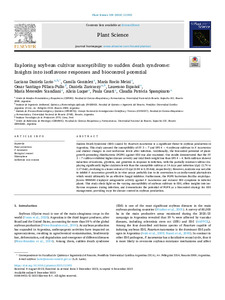Por favor, use este identificador para citar o enlazar este ítem:
https://repositorio.uca.edu.ar/handle/123456789/18387| Título: | Exploring soybean cultivar susceptibility to sudden death syndrome : Insights into isoflavone responses and biocontrol potential | Autor: | Lario, Luciana Daniela González, Camila Meini, María Rocío Pillaca Pullo, Omar Santiago Zuricaray, Daniela Español, Laureano Scandiani, María Mercedes Luque, Alicia Casati, Paula Spampinato, Claudia |
Palabras clave: | SOJA; PRODUCCION AGRICOLA; FUSARIUM TUCUMANIAE; BACTERIAS; CONTROL DE ENFERMEDADES; ISOFLAVONAS | Fecha de publicación: | 2024 | Editorial: | Elsevier | Cita: | Lario, L. D. et al. Exploring soybean cultivar susceptibility to sudden death syndrome : Insights into isoflavone responses and biocontrol potential [en línea]. Plant Science. 2024, 339(111951). doi: 10.1016/j.plantsci.2023.111951. Disponible en: https://repositorio.uca.edu.ar/handle/123456789/18387 | Resumen: | Abstract: Sudden Death Syndrome (SDS) caused by Fusarium tucumaniae is a significant threat to soybean production in Argentina. This study assessed the susceptibility of SY 3 × 7 and SPS 4 × 4 soybeans cultivars to F. tucumaniae and studied changes in root isoflavone levels after infection. Additionally, the biocontrol potential of plantgrowth promoting rhizobacteria (PGPR) against SDS was also examined. Our results demonstrated that the SY 3 × 7 cultivar exhibited higher disease severity and total fresh weight loss than SPS 4 × 4. Both cultivars showed induction of daidzein, glycitein, and genistein in response to infection, with the partially resistant cultivar displaying significantly higher daidzein levels than the susceptible cultivar at 14 days post infection (dpi) (2.74 vs 2.17-fold), declining to a lesser extent at 23 dpi (0.94 vs 0.35-fold, respectively). However, daidzein was not able to inhibit F. tucumaniae growth in in vitro assays probably due to its conversion to an isoflavonoid phytoalexin which would ultimately be an effective fungal inhibitor. Furthermore, the PGPR bacterium Bacillus amyloliquefaciens BNM340 displayed antagonistic activity against F. tucumaniae and reduced SDS symptoms in infected plants. This study sheds light on the varying susceptibility of soybean cultivars to SDS, offers insights into isoflavone responses during infection, and demonstrates the potential of PGPR as a biocontrol strategy for SDS management, providing ways for disease control in soybean production. | URI: | https://repositorio.uca.edu.ar/handle/123456789/18387 | ISSN: | 0168-9452 | Disciplina: | QUIMICA | DOI: | 10.1016/j.plantsci.2023.111951 | Derechos: | Acceso abierto | Fuente: | Plant Science. 2024, 339(111951) |
| Aparece en las colecciones: | Artículos |
Ficheros en este ítem:
| Fichero | Descripción | Tamaño | Formato | Login |
|---|---|---|---|---|
| exploring-soybean.pdf | 3,94 MB | Adobe PDF | SOLICITAR ACCESO | |
| exploring-soybean.png.pdf | 204,46 kB | Adobe PDF |  Visualizar/Abrir |
Este ítem está sujeto a una Licencia Creative Commons

